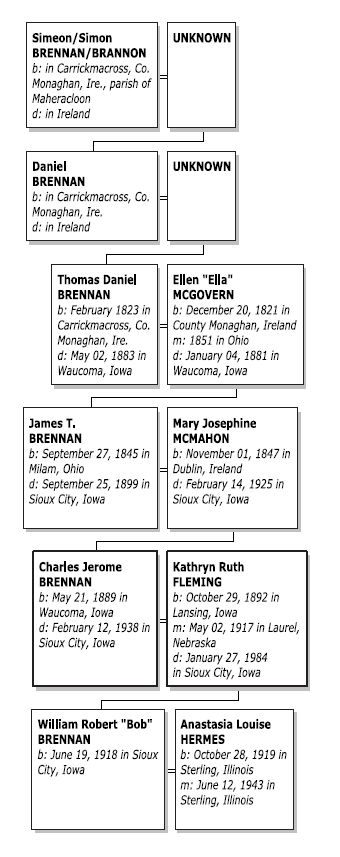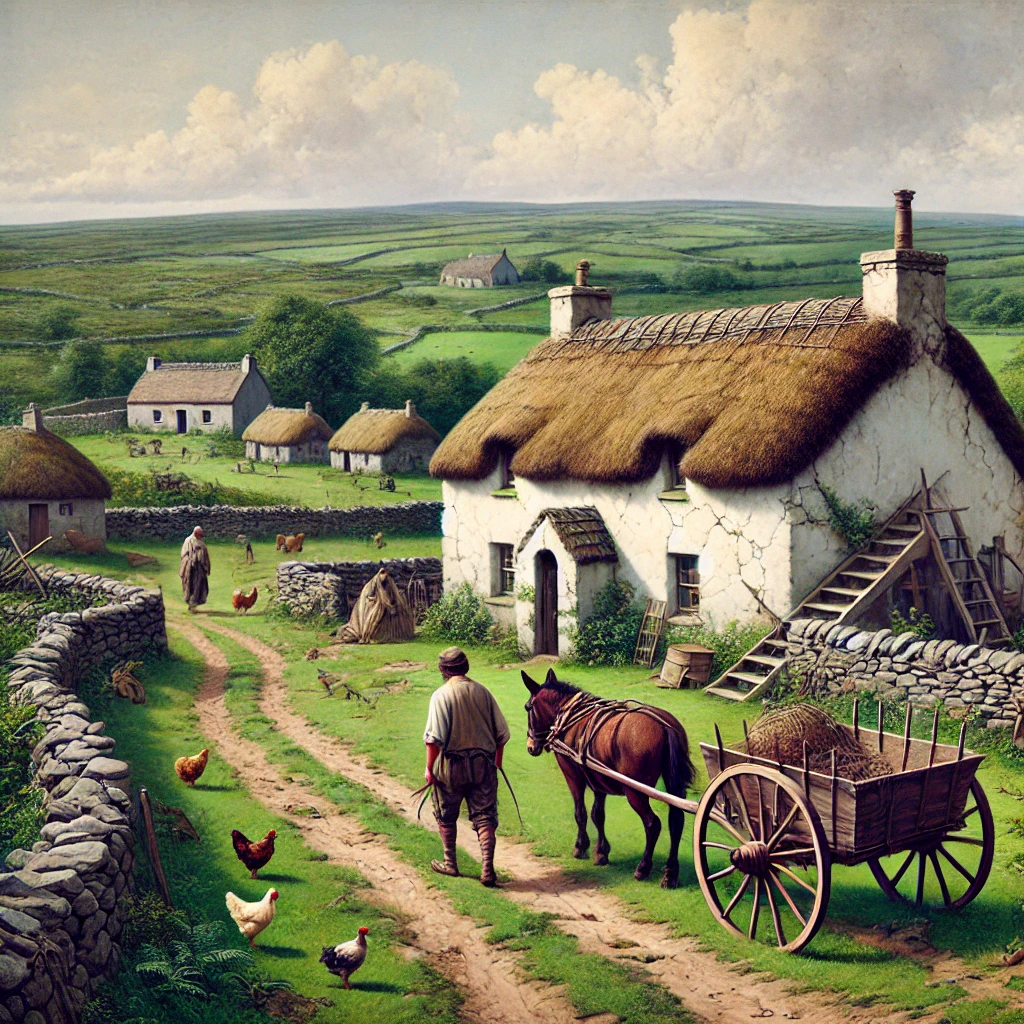 The patrilineage of W. Robert “Bob” Brennan.
The patrilineage of W. Robert “Bob” Brennan.Why is genealogy—the intricate web of relationships extending through time—so bloody fascinating? I’ve made attempts to contribute to mine on WikiTree1, but have reluctantly come to the realization that I don’t have what it takes in the passion and patience departments to be a family historian.
Yet when Mom’s cousin recently shared a pdf of a sprawling family tree (with the characteristic breadth of Irish Catholic families), I found myself drawn back into the mystery of my family pedigree:
 The patrilineage of W. Robert “Bob” Brennan.
The patrilineage of W. Robert “Bob” Brennan.
I knew my maternal grandfather Bob Brennan well and, being on the older end of his grandchildren, I’ve been privy to some details and stories about his parents. But, of course, those details grow sparser with each generation to the point where once you go back to Ireland (pre-emigration), key dates and spouses are altogether missing.
So looking at this family tree I began wondering about “Simeon/Simon”, my earliest Brennan ancestor who had a name (or at least an approximation of one) and a location, but nothing else to fill in his identity.
Who was he? How was he described at his funeral? Did he have that famous Irish wit? And if ‘no’, then how, begorra, did he woo his wife, whose name is lost to time? Etc.
Maybe I can’t piece together Simeon’s documented life story via proper genealogy, but couldn’t I enlist other tools of the present age to help imagine the past he inhabited? After all, “genealogy without documentation may be mythology,” but mythology still has value in helping us understand ourselves, right?
Which “other tools of the present age”? Our new-fangled large language models2, of course. First of all, just to guesstimate a birth date (based on his grandson’s birthdate of February 1823), and sure enough, “based on historical marriage and childbearing patterns in rural Ireland during that period” Simeon was most likely born somewhere between 1763 and 17733.
And so if Simeon reached young adulthood during the late 18th century, what would life have been for him during that period?
Apparently, County Monaghan in the late 1700s was primarily agricultural, and, specifically, dominated by the linen industry (and later known for lace-making). So I wonder if Simeon was, in fact, a flax farmer? Or perhaps growing subsistence crops (potatoes, oats)? Or both? And if he grew flax was his household vertically integrated such that they did some linen weaving as well to make ends meet?
If we assume he was a farmer and Catholic (as his descendants were), he would have occupied a lower position in the social and economic hierarchy, as the upper ranks were reserved for Anglo-Irish Protestant landowners—likely including his own landlord. So Simeon and his family would’ve been of modest means, possibly living in a humble one-room cabin with an earthen floor and thatched roof.
 A bucolic late 18th century County Monaghan as imagined by OpenAI’s text-to-image model (DALL·E).
A bucolic late 18th century County Monaghan as imagined by OpenAI’s text-to-image model (DALL·E).
I imagine Simeon going into the town of Monaghan on a Saturday morning to sell his produce and linen at the market, and interacting with the locals he doesn’t get a chance to see every day.
I wonder how much religious persecution Simeon would’ve faced? There were these Penal Laws for Catholics, which I imagine could’ve affected him in his youth, but were pretty well repealed by the time he was a man. Even as some of the laws relaxed, though, Catholics like Simeon still faced significant barriers: no right to vote (unless they met substantial property requirements) and forced to pay tithes to the Anglican Church (as were the Presbyterians). The United Irishmen movement would’ve been fighting for reforms during this time, and while it wasn’t centered in a rural place like County Monaghan, Simeon might still have felt its effects.
If a time machine could take me back to late 18th century Carrickmacross, I’d want to run all these questions (and more) by him…but would I have been able to understand him properly? I’m going to venture a ‘yes’. Even though I’m sure his storytelling was in Irish, English in Monaghan was becoming increasingly dominant due to the linen trade and a shift in the Church toward English; so even if Simeon wasn’t formally educated he probably had enough English under his belt to have a chat with his 5× great grandson, assuming I could decipher his brogue or he my funny American accent.
Simeon, if ye be in Heaven, forgive all the AI-enabled mythology I’ve concocted, and pray for your Brennan progeny this St. Patrick’s Day.
Sláinte,
— ᴘ. ᴍ. ʙ.
WikiTree seems to have their stuff together as far as mission and vision. (I was previously using Geni but it’s a little clunky and the business model / monetization strategy ultimately undermines the desired network effect.) ↩
Claude 3.7 Sonnet from Anthropic. ↩
I probably should do some fact-checking on some of this output since these early LLMs are world-class “confident b.s.ers”. ↩